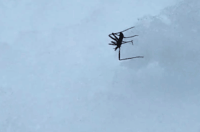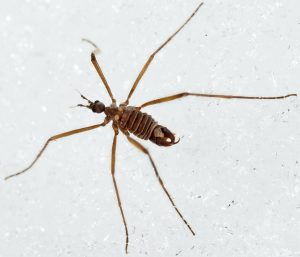
Before you go:
- Learn to identify a snow fly. Chionea look like crane flies without wings (skinny body, six legs). They are typically very active, running across the surface of the snow with their long legs. Check out the snow fly gallery for example videos and photos.
- Find a container to collect snow flies. We recommend using a 5 mL plastic centrifuge tube with a snap cap, which you can order from Amazon. You can also use a pill bottle or other small sealable container.
- Obtain permission, if needed. The US Forest Service has told us that a permit is not needed to collect snow flies on public lands. But make sure to obtain permission if you are collecting in other locations.
- Optional: Download the iNaturalist app. Set it up following these instructions.

In the field:
Step 1: Find snow flies. We typically encounter them on fresh fluffy, snow within 500 m of the tree line (e.g., 1200-2500 m in the Cascades) from November to March. Ideal weather conditions are windless, clear, and temperatures just below freezing. They are often easiest to spot in open meadows, because of the lack of other debris from trees, though they can also be found in the forest on recently fallen snow. We rarely find snow flies when it is windy or if the snow is hard-packed or crusty. Even in ideal conditions, it often takes an hour or two of searching to find a snow fly.
Step 2: Gently coax or scoop the live snow fly into the container and seal it. Add a few flakes of snow, equivalent to one small water droplet (~0.1 mL). This will allow the snow fly to stay hydrated. If you add too much snow or water, the snow fly may drown.

- We prefer to receive snow flies alive, to study their behavior, but if the fly does not survive collection, you can add some rubbing alcohol to the tube when you get home. This will preserve the fly so we can sequence its DNA.
- We recommend 1-2 flies per tube, but if needed, you can collect up to 5 snow flies in a single tube.
- Optional: Share a photo or video with us on social media (@snowflyproject on Twitter and Instagram).
- Optional: upload a photo of the snow fly to iNaturalist’s mobile app while still at the collection site. This will capture your current GPS coordinates based on your location (iNaturalist instructions). In the comment section, provide the number of specimens collected, behavioral observations, weather, snow conditions, etc.
At home:
Step 3: Store the collection tube and snow flies in your refrigerator. They will survive there for a week or more, provided they have access to a drop of water.
- Do not put snow flies in the freezer. Without access to snow or liquid water, snow flies will dehydrate and die.
Step 4: In an email to snowflyproject@uw.edu, let us know that you would like to ship or drop off collected specimens. Please include the collection site (preferably GPS coordinates), collection date, collector’s name, and additional information, including pictures or video.
- If needed, we are happy to send you a prepaid shipping label (USPS, FedEx, or UPS).
Step 5: Ship collection tubes with snow flies to:
John Tuthill
University of Washington
Department of Physiology & Biophysics
1705 N.E. Pacific Street, Box 357290
Seattle, WA 98195
If you are local to Seattle, you can drop off snow fly specimens at the Tuthill Lab: University of Washington, 1705 N.E. Pacific Street, Health Sciences Building (HSB), Seattle. UW students, staff, and faculty can also use the campus mail for free.
- For packaging, a standard Fedex or Priority Mail envelope (12.5″ x 9.5″) works fine. Wrapping the tube(s) in some scrap paper or plastic provides some extra cushioning. Insulation is helpful, but not required. Overnight shipping is also helpful, but not required.
